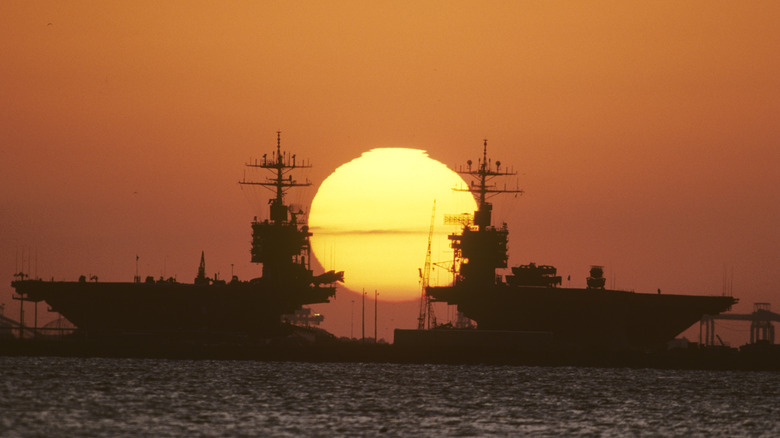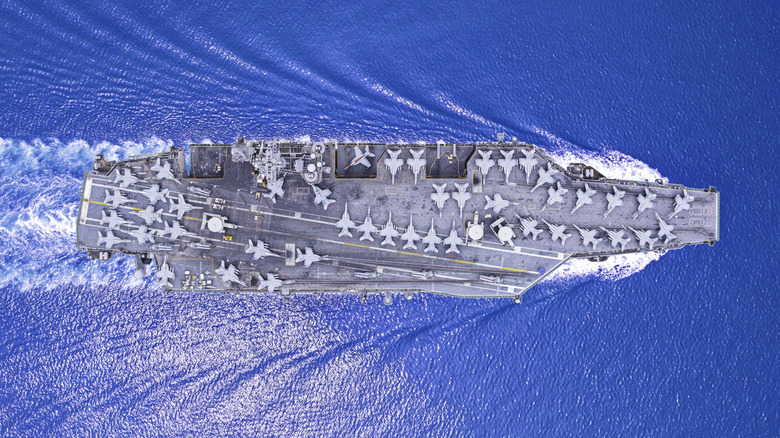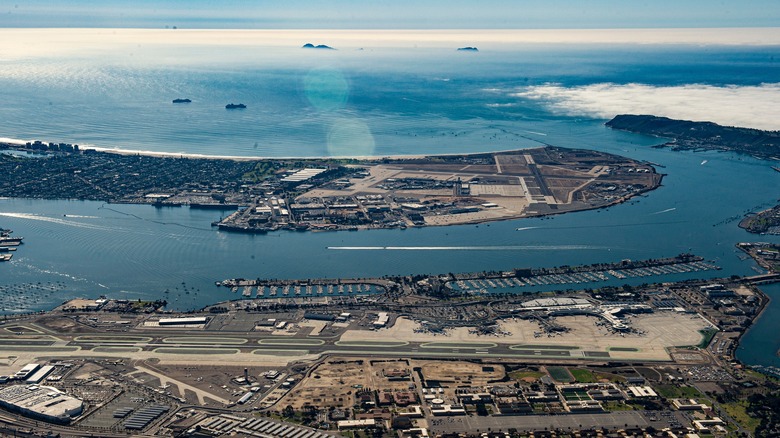
Karen Kasmauski/Getty Images
The United States Navy currently has 11 aircraft carriers in its fleet. These big floating cities of the sea, bristling with a staggering array of high-tech armaments, are strategically located around the globe to more effectively move into action when needed. A few of these leaders of a Carrier Strike Group (CSG) or Carrier Battle Group (CVBG) are now actively deployed, while others are preparing to head out to sea. And some are at their homeport getting general maintenance done.
Three active aircraft carriers currently call San Diego homeport, while four others (and the still-in-the-works PCU John F. Kennedy) are part of Naval Air Force Atlantic (AIRLANT), and are based in and around Norfolk, Virginia. Each of these «supercarriers» has a lifespan of 50 years before getting decommissioned and has one scheduled midlife refueling point — basically, a stem-to-stern inspection and refurbishment to ensure the carrier will last the remainder of its mission.
Some of the largest warships on the planet, 10 of 11 Navy ships are of the 100,000-ton, nuclear-powered Nimitz class. The other is the USS Gerald R. Ford (CVN 78), the first of the new Ford-class carriers deployed in 2022 (which in itself was the first new class in over 40 years), and is even bigger than the Nimitz carriers. The newest 12th vessel, the PCU John F. Kennedy (CVN 79), will set sail sometime in 2025.
Homeport doesn’t mean idly docked

General_4530/Getty Images
The midlife refueling process of these vessels can take several years. The ship’s nuclear reactor and compartment are rigorously checked to ensure they’re operating safely and, if needed, repaired or refurbished. Additionally, the spent nuclear fuel is removed and replaced with new fuel. Things such as propulsion systems, power generation, shipboard combat systems, the carrier’s flight deck, and launch gear mechanisms are also checked. Currently, at the Naval Air Station (NAS) North Island in San Diego are the USS Carl Vinson, USS Theodore Roosevelt, and USS Abraham Lincoln. Meanwhile, the USS Dwight D. Eisenhower (CVN 69), USS Harry S. Truman (CVN 75), USS George H. W. Bush (CVN 77), and USS Gerald R. Ford (CVN 78) all call the Eastern seaboard their homeport.
Although these ships have a «homeport» designation, that doesn’t necessarily mean they remain docked, just waiting for something to happen. For instance, as of mid-June 2024, four carriers are currently deployed. The Eisenhower was out in the Red Sea, the Reagan (which was stationed in Japan) was patrolling the Philippine Sea, the Roosevelt was in the South China Sea as part of the Indo-Pacific Command, and the Washington was en route to Japan to replace the USS Ronald Reagan.
Truman, Vinson, and Lincoln are preparing to deploy. Truman is expected to set sail in October or November, while Vinson and Lincoln will deploy in July. The Lincoln will head to Pacific Command while the Vinson first goes to Rim of the Pacific (RIMPAC) and later on to Pacific Command.
Naval Air Station North Island has history

Aqeela_Image/Shutterstock
Meanwhile, four other carriers are currently in various states of repair. The USS Stennis (named after Senator John Cornelius Stennis, the carrier’s namesake, hailed from Mississippi) is presently in «RCOH» (major refueling complex overhaul), a process where the ship’s electronics, combat, and propulsion systems are upgraded. This can take up to four years. It entered RCOH in May 2021, so it isn’t expected to be ready until 2025. USS Nimitz began its maintenance cycle in October 2023 and is expected to be completed in the latter half of 2024. USS Bush just started its midlife refueling process in December, so it will be in drydock for some time. The USS Ford recently returned from deployment and should be in the maintenance bay for about a year.
As for NAS North Island, the Navy has said it is home to three carriers, but that might be all three at once, or two North Island-homeported ships with a third being a «transient aircraft carrier,» like the Ford or Kennedy (once it’s deployed), which it has said will occasionally dock there. A full-time fourth carrier is not currently in the plans.
Until 1955, North Island was referred to as NAS San Diego and has been recognized as the «Birthplace of Naval Aviation» since its history stretches back to when it was first designated as a naval air station in 1917. At one time (1935), all four of the Navy’s carriers ported at North Island, including the USS Langley, USS Lexington, USS Saratoga, and USS Ranger.